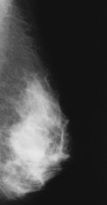- AI
- Molecular Imaging
- CT
- X-Ray
- Ultrasound
- MRI
- Facility Management
- Mammography
Dense Breast Tissue Legislation Presents Challenges for Practitioners
It’s been two years since Connecticut enacted a law requiring providers to tell patients in writing if they have dense breast tissue, and other states are following suit. But practitioners say complying with the law is often complicated.

It’s been two years since Connecticut enacted a law requiring providers to tell patients in writing if they have dense breast tissue. Research shows that breast cancer detection is up in the state, but industry leaders and practitioners say complying with the law is often complicated.
The move to include specific breast density information in a letter about mammography results was borne out of one Connecticut patient’s diagnosis with late-stage breast cancer. Doctors missed the malignancy because she had dense breast tissue. Her experience eventually led the state to pass a law, mandating providers inform patients of their breast tissue status. These letters have led to supplemental ultrasound screenings.
Other states are following suit. On Jan. 1, Texas enacted its version of dense breast legislation, known as Henda’s Law, and the American College of Radiology (ACR) anticipates 13 other states will introduce dense breast bills this year. Legislation has also been introduced at the federal level, but it hasn’t yet gained traction. And the potential lack of national continuity could be problematic.
“If a mandate to give patients breast density information happens state-by-state, it will be piecemeal. A national effort would, hopefully, put people all on the same page,” said Barbara Monsees, MD, chair of the ACR’s Breast Imaging Commission. “Differing laws proposed by different states could result in providers having an inconsistent understanding of what they are required to do.”
While the ACR supports patient education and notification about breast cancer risk, the organization cautions that without a standardized method for determining breast density, making categorizations is subjective. Without clear guidelines, different radiologists could rate the breast tissue differently based on the same mammogram. In addition, breast density is only one facet of breast cancer risk - others, such as family history or genetic disposition, play larger roles.
There are some tools under development that could help radiologists categorize breast tissue, she said, but none are yet commercially available. And, unless all radiologists use them, they won’t be completely effective.
Recent research from the University of Connecticut School of Medicine at Farmington, however, shows the state’s dense breast law has resulted in more cancer detection. But the false-positive rate and number of performed biopsies have also increased. And, financially, it’s been pricey: Each cancer found costs, on average, $110,000.
The data, presented at last fall’s Radiological Society of North America annual meeting, showed that, out of nearly 77,000 patients, roughly 50 percent of women who had dense breast tissue returned for supplemental ultrasound screening. Overall, those screenings had a positive predictive value of 4 percent and identified 28 additional cancers.
Alongside the increased cost, radiologists worry informing patients about their breast density could lead to additional studies being conducted without the clinical evidence to support doing so.
“There are a lot of radiologists opposed to this legislation largely because we don’t know if we can say we have the case-controlled, blind prospective studies that show this is a benefit for the patients,” said Michael Ulissey, MD, director of breast imaging at Parkland Comprehensive Breast Center in Dallas. “We’re now doing these ultrasound screenings, and we have no evidence that it’s beneficial for the population as a whole.”
Although it’s too early in Texas to judge whether the law has increased workflow, Connecticut radiologists have seen an increase in the number of supplemental ultrasound screenings they perform. During the RSNA meeting, Kathryn Greenberg, MD, chief radiology resident at Yale-New Haven Hospital, reported her practice has gone from not conducting supplemental ultrasounds before the law passed in 2009 to providing approximately 40 screenings each day.
The ultrasounds are comparable to mammography for finding breast cancer, but they fall below expectations when it comes to procuring a positive biopsy, she said. Out of nearly 950 patients, Greenberg performed 60 biopsies - only an additional three cancers were found. With each screening lasting between 30 to 45 minutes, the workload for technologists and radiologists has gotten heavier.
In many cases, supplemental ultrasounds are farmed out to specialty breast centers that are better equipped to provide the service, Ulissey said. But even with the added expertise, the influx of patient volume in these facilities does put added stress on the staff.
There is also a worry among industry leaders that these laws could chip away at the public’s trust in mammography as a cancer screening tool. This problem could arise if women receive differing letters about their breast tissue density from year-to-year due to the lack of standard categorization.
“It’s a dangerous, slippery slope because this legislation could cause people to lose faith in mammography,” Ulissey said. “We already have women with dense breast tissue skipping one or two years, and if they begin to think that ultrasound is more effective than mammography, there’s a big potential for harm.”
Computed Tomography Study Assesses Model for Predicting Recurrence of Non-Small Cell Lung Cancer
January 31st 2025A predictive model for non-small cell lung cancer (NSCLC) recurrence, based on clinical parameters and CT findings, demonstrated an 85.2 percent AUC and 83.3 percent sensitivity rate, according to external validation testing in a new study.
